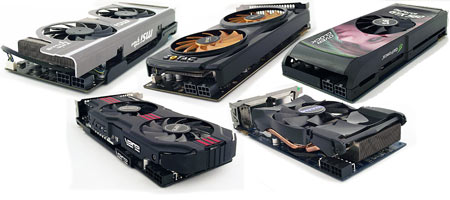Five Overclocked GeForce GTX 560 Cards, Rounded-Up
We were foiled in our quest to find the best vendor-provided GPU cooler for Nvidia's GeForce GTX 560. But out of the ashes sprung a round-up of cards armed with those very same solutions. Which of these five GF114-based boards is right for you?
GeForce GTX 560 In Nvidia's $200 Range
This story was conceptualized as a means to compare graphics card coolers from different vendors. Because no two GPUs have the exact same overclocking headroom, we wanted to take one GeForce GTX 560 and drop solutions from Asus, ECS, Galaxy, MSI, and Zotac onto that bare board. With thermal, acoustic, and performance data, we would have been able to give you a definitive answer as to whose heat sink and fan combination does the best job of pulling heat away from Nvidia's GPU. Surely, this would have been great information to have when overclocking.
Unfortunately, that plan was foiled by a number of variables that we simply couldn’t overcome to our satisfaction. For example, the cooler designers employ a surprisingly diverse range of fan power cable plugs, which aren't interoperable with any one card's connector. Moreover, fan temperature profiles vary from one card's firmware to another's, affecting our thermal and acoustic results.
With five GeForce GTX 560 cards in-hand, though, we still had the makings of a respectable round-up. So, we abandoned the idea of isolating cooler/fan effectiveness and forged ahead to bring you a comprehensive look at five examples of Nvidia's roughly-$200 contender.
| Header Cell - Column 0 | Asus GTX 560DirectCU II TOP | ECS BlackGTX 560 | Galaxy MDT4GeForce GTX 560 | MSI N560GTXTwin Frozr II OC | Zotac GeForce GTX 560 AMP! |
|---|---|---|---|---|---|
| GraphicsClock | 925 MHz | 870 MHz | 830 MHz | 870 MHz | 950 MHz |
| ShaderClock | 1850 MHz | 1740 MHz | 1660 MHz | 1640 MHz | 1900 MHz |
| MemoryClock | 1050 MHz | 1000 MHz | 1002 MHz | 1020 MHz | 1100 MHz |
| GDDR5Memory | 1 GB | 1 GB | 1 GB | 1 GB | 1 GB |
| Cooler | DirectCU II | Reference | Custom | Twin Frozr II | Custom |
| Size | 10.25" x 5" | 9.5" x 5" | 8.75" x 5" | 10" x 5" | 9.5" x 5" |
| Connectors | 2 x DL-DVI, 1 x mini-HDMI | 2 x DL-DVI, 1 x mini-HDMI | 4 x DVI, 1 x mini-HDMI | 2 x DL-DVI, 1 x mini-HDMI | 2 x DL-DVI, 1 x mini-HDMI |
| Form Factor | Dual-slot | Dual-slot | Dual-slot | Dual-slot | Dual-slot |
| GPUVoltage | 0.912 V Idle1.012 V Load | 0.950 V Idle0.987 V Load | 0.912 V Idle0.987 V Load | 0.912 V Idle0.987 V Load | 0.912 V Idle 1.15 V Load |
| GPU VoltageAdjustment | AsusSmartdoctor | Not supported(MSI Afterburner) | Galaxy XtremeTuner HD | MSIAfterburner | Not supported(Stock 1.15 V) |
| SpecialFeaturesAnd Software | N/A | N/A | Quad-DisplaySupport | Includes game:Lara Croft andthe Guardian of Light | Includes game: Assassin's Creed:Brotherhood |
| Warranty | 3-Year parts & labor | 2-Year labor 3-Year parts | 2-Year labor3-Year parts(if registered in 30 days) | 3-Year parts & labor | 2-Year Standard,Limited Lifetime Extended(if registered in 30 days) |
| NeweggPrice | $219.99 | $192.99 | $229.99 | $199.99 | $219.99 |
As you can see, there’s a wide range of specifications applied to these cards, none of which match Nvidia’s reference 810 MHz core and 1002 MHz frequencies. The Galaxy model comes closest with its 830/1002 MHz clocks, but Zotac's AMP! edition goes all the way to 950/1100 MHz.
There’s a lot more distinguishing one board from the others than operating clock rates, though, as all of the coolers are unique as well. There's only one that matches the reference design. Some cards also include value-adds like games, and the Galaxy MDT supports as many as four display outputs and triple-monitor surround gaming. Of course, we also have to gauge how far our samples can be overclocked.
Get Tom's Hardware's best news and in-depth reviews, straight to your inbox.
Current page: GeForce GTX 560 In Nvidia's $200 Range
Next Page Asus GTX 560 DirectCU II TOPDon Woligroski was a former senior hardware editor for Tom's Hardware. He has covered a wide range of PC hardware topics, including CPUs, GPUs, system building, and emerging technologies.
-
pensivevulcan Kepler is around the corner, so are lower end AMD 7000 series parts, this was interesting but wouldn't one want to wait for a plethora of reasons.Reply -
payneg1 The Galaxy model comes closest with its 830/1002 MHz clocks, but Zotac's AMP! edition goes all the way to 950/1100 MHz.Reply
This dosent match with the above chart -
crisan_tiberiu so, basicaly if someone plays on a single monitor, there is no point going beyond a gtx 560 or a 6950 in today's games. (it slike in the "best gaming CPU chart", no point going beyond i5 2500k for gaming.Reply -
giovanni86 salad10203Are those temps for real? My 280 gtx has never idled under 40C.Your kidding right, my overclocked 580GTX at 60% fan speed idles at 32c. Cards down clock themselves which allows them to run cooler at idle temps even if it were clocked at upwards i don't think a card would get hot unless it was being used.Reply -
justme1977 crisan_tiberiuReply
I have the feeling that even a i5 2500k@4ghz bottlenecks a 7970 @1080p in most newer games.
If the GPU market goes the way it does, it won't take long that even midrange cards will be bottlenecked @1080p by the cpu.
-
FunSurfer I think there is an error on the Asus idle voltage: instead "0.192 V Idle" it should be 0.912Reply
